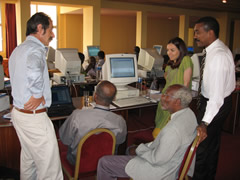 Estimates workshops have been designed to enable
Estimates workshops have been designed to enable
epidemiologists to develop the best possible
HIV estimates for their country.
Photo credits: UNAIDSBetween March and June 2007, national epidemiologists, analysts and heads of AIDS programmes from 124 countries have taken part in specialist UNAIDS training to improve and refine country HIV estimates.
Eleven regional training workshops have been conducted around the world to bring epidemiologists up to date with the latest developments in estimates tools and software packages including updated assumptions based on new evidence from research and added new features.
The workshops are intended to build capacity in countries to produce updated 2005 and provisional 2007 estimates. Global and regional estimates based on these preliminary country estimates will be published at the end of 2007 in the 2007 AIDS Epidemic Update and new country estimates will be published in the 2008 UNAIDS Report on the global AIDS epidemic in time for the 2008 International AIDS Conference in Mexico.
“These trainings have been designed to enable epidemiologists to develop the best possible HIV estimates for their country, based on the latest improvements in data collection methods,” said Karen Stanecki, UNAIDS senior epidemiological advisor, who helped facilitate the workshops. “Epidemiologists will be able to develop data to inform different aspects of the AIDS response, such as the number people living with HIV, new HIV infections, need for antiretroviral treatment, and the number of deaths and orphans related to AIDS,” she said.
Since 1997 country specific estimates of the burden of HIV infection have been published by UNAIDS and WHO on a regular basis. The methods and assumptions used to produce HIV estimates have been improved based on increased knowledge of the HIV epidemic and its dynamics in different populations. The development of these methods has been guided by recommendations of the UNAIDS Reference Group on Estimates, Modelling and Projections.
Over the past few years specific software programmes have been developed, including the Workbook and the Estimation and Projection Package (EPP) to generate an epidemic curve of the HIV epidemic, based on sentinel HIV sero-surveillance data. Another software package (Spectrum) uses the epidemic curve as an input, and generates estimates of prevalence, incidence, and AIDS-related mortality, as well orphans. Some of the Spectrum outputs include as denominators for Monitoring and Evaluation indicators for prevention of mother to child transmission and antiretroviral treatment need. These software packages have been used by UNAIDS and WHO to produce the 2001, 2003 and 2005 estimates.
Bringing participants up to date with the latest in new data collection developments, the specialist training workshops were held across all regions in South Africa (two sessions), Senegal (two sessions), Thailand (two sessions), Panama (two sessions), Trinidad and Tobago, the Russian Federation and Egypt.
Strengthening regional methods
 Participants of the MAP meeting in
Participants of the MAP meeting in
Moscow identified the main
determinants of the epidemic in the
region and analyzed its impact.
Photo credits: UNAIDSFurther developing methods and practices for greater data collection, the second “ Commonwealth of Independent States Monitoring the AIDS Pandemic (MAP) meeting” was conducted in Moscow , Russian Federation , 25-27 June 2007. The meeting brought together eighty participants and observers from the twelve countries of the Commonwealth of Independent States, including experts from the National AIDS Programmes of Azerbaijan, Armenia, Byelorussia, Georgia, Kazakhstan, Kyrgyzstan, Moldova, Russia, Ukraine, Uzbekistan, Tajikistan and Turkmenistan.
“The meeting was especially significant since it was the first time in ten years that this group of regional experts had assembled to examine the trends that are driving one of the world’s fastest growing HIV epidemic,” said Liliya Mialeshko, Head of the AIDS Prevention Department of the Republican Center for Hygiene, Epidemiology and Public Health in Belarus, who participated in the meeting.
Supported by technical guidance from the UNAIDS Secretariat, the World Health Organization and the U.S. Centers for Disease Control, as well as UNAIDS’ co-sponsors, donors and non-governmental organizations, the meeting allowed participants to assess the main determinants of the epidemic in the region, review trends in biological and behavioural surveillance, and share best practices in the collection and use of data to guide the response to the epidemic. The MAP meeting was followed by the final regional HIV estimates training workshop.
“Both the MAP meeting and the estimations workshops have helped further the critically important work of identifying the main drivers of the epidemic in the region and determining its impact. By helping countries to better “Know Their Epidemics”, they will be better able to develop an effective response,” said Karen Stanecki.
UNAIDS is now working individually with country representatives to finalize the report from the regional meeting and develop plans for further follow-up.





